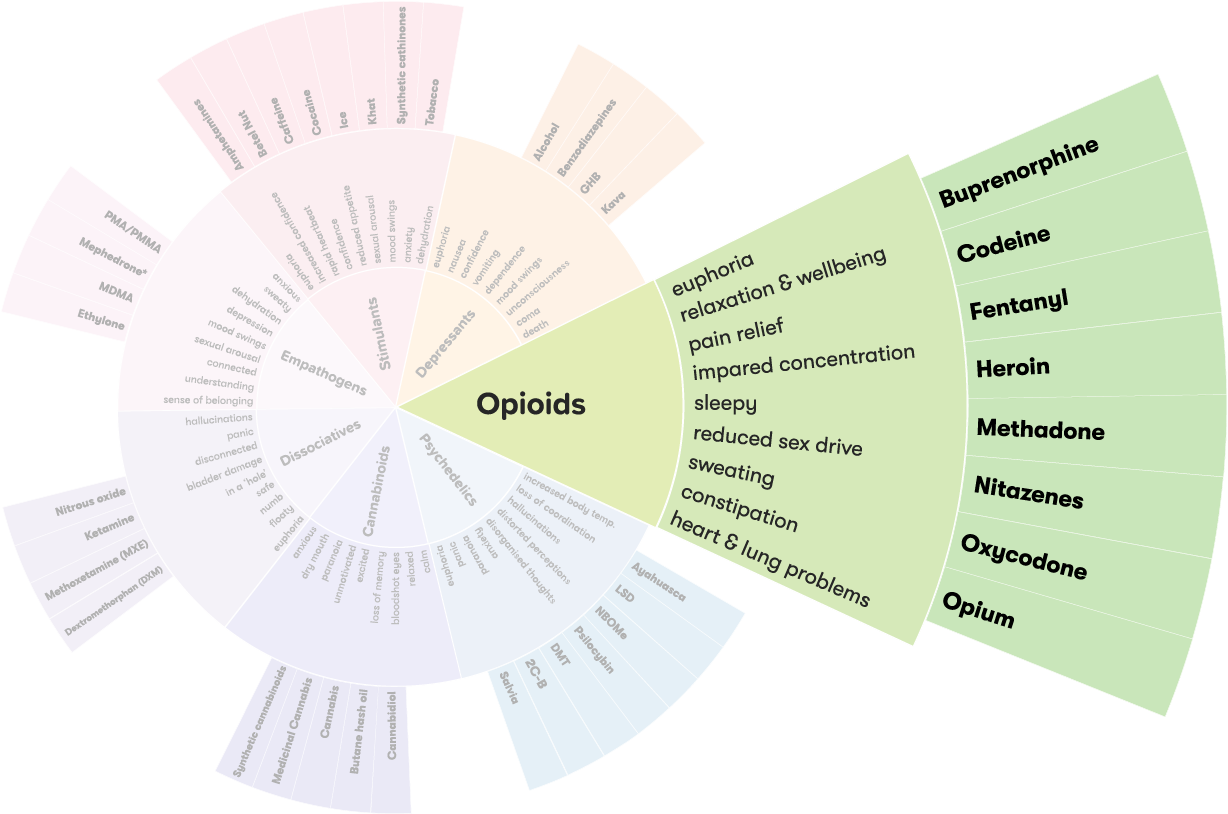Other names
Codeine may also be known by a brand or trade name. Some common examples are:
| Generic name | Brand names |
|---|---|
| Aspirin and codeine | Aspalgin®, Codral Cold & Flu Original® |
| Ibuprofen and codeine | Nurofen Plus® |
| Paracetamol and codeine | Panadeine Forte®, Panamax Co® |
| Paracetamol, codeine and doxylamine | Mersyndol® and Mersyndol Forte®, Panalgesic® |
How is codeine used?
Codeine is usually swallowed but can also be used as a suppository or intramuscular injection.5
Effects of codeine
Use of any drug can have risks. It’s important to be careful when taking any type of drug. Even medications can produce unwanted side effects.
Codeine affects everyone differently, based on:
- the person’s size, weight and health
- whether the person is used to taking it
- whether other drugs are taken around the same time
- the amount taken.
Codeine is used for relief from various conditions, including:
- mild to moderate pain
- severe pain (when combined with aspirin or paracetamol)
- dry irritating cough
- diarrhoea
- cold and flu (when combined with antihistamines and decongestants).2
Side effects
The most common side effects of codeine are:
- dizziness
- tiredness
- confusion, difficulty concentrating
- euphoria
- restlessness
- blurred vision
- dry mouth
- limbs feeling heavy or muscles feeling stiff
- sweating
- mild allergic rash, itching and hives
- low blood pressure
- decreased heart rate, palpitations
- stomach-ache, nausea, vomiting, constipation
- difficulty urinating.6,7
These side effects may disappear with continued treatment. However, if they persist, speak to a medical practitioner.
Overdose
If the dose is too high, you might overdose. Call triple zero (000) and request an ambulance if you or someone else has any of the following symptoms (emergency services are there to help and can provide instructions over the phone):
- inability to pass urine
- severe constipation and obstructed bowel
- agitation
- cold clammy skin with a bluish tinge
- mental numbness
- very slow, shallow breathing
- hallucinations and sometimes seizures
- coma and death.1
Long-term effects of codeine
Regular use of codeine may eventually cause:
- constipation
- reduced sex drive
- irregular periods
- tension and muscle twitches
- needing to use more to get the same effect
- tolerance and dependence on codeine
- financial, work and social problems.2,7,12
It’s important to discuss the side effects of long-term use with a medical practitioner.
Tolerance and dependence
People who use codeine regularly can develop dependence (addiction) and tolerance to it. This means they need to take larger amounts of the drug to get the same effect.5
Mixing codeine with other drugs
Mixing codeine with other drugs can have unpredictable effects and increase the risk of harm.
- Codeine and methamphetamine/cocaine: can cause risk of heart strain and respiratory arrest.
- Codeine and GHB/GBL: can cause difficulty breathing, passing out, and possible death.
- Codeine and Ketamine: can cause nausea, vomiting, passing out and possible death.
- Codeine and benzodiazepines/alcohol: can cause overdose, passing out, difficulty breathing, memory loss and possible death.8,9,11
More on Polydrug use
Polydrug use is a term for the use of more than one drug or type of drug at the same time or one after another. Polydrug use can involve both illicit drugs and legal substances, such as alcohol and medications.
Reducing harm
- Always carry naloxone for emergencies, and encourage family and friends to learn how to use take home naloxone – a medicine that can reverse the effects of an opioid overdose (more information on naloxone is provided below).
- Avoid mixing drugs (polydrug use) – mixing opioids with depressant drugs such as alcohol or benzodiazepines can greatly increase the risk of overdose.
- Use codeine where you feel safe and with people you trust, and always tell someone what you’ve taken.
- Test a small amount first to reduce overdose risk.
- Do not drive or operate machinery after use.
- Always use sterile injecting equipment and never share injecting equipment.
- Safely dispose of used injecting equipment.8-11
'Polydrug use’ is a term for the use of more than one drug or type of drug at the same time or one after another. Polydrug use can involve both illicit drugs and legal substances, such as alcohol and medications.
Withdrawal
Giving up codeine after a long time is challenging because the body has to get used to functioning without it. Please seek advice from a health professional.
Withdrawal symptoms usually start within a few hours after the last dose and become strongest between 48 and 72 hours.13 Symptoms include:
- cravings for codeine
- seeking codeine containing medicines
- dilated pupils
- abdominal cramps, diarrhoea, nausea, vomiting
- lack of appetite
- flu like symptoms such as runny nose, sneezing, sweating, chills and fever
- yawning and difficulty sleeping
- trembling, aching muscles and joints
- goosebumps
- restlessness, irritability, nervousness, depression.6,12,7
Getting help
If your use of Codeine is affecting your health, family, relationships, work, school, financial or other life situations, you can find help and support.
Call the National Alcohol and Other Drug Hotline on 1800 250 015 for free and confidential advice, information and counselling about alcohol and other drugs
Help and Support Services search
Find a service in your local area from our list. Simply add your location or postcode and filter by service type to quickly discover help near you.
If you're looking for other information or support options, send us an email at druginfo@adf.org.au
Path2Help
Not sure what you are looking for? Try our intuitive Path2Help tool and be matched with support information and services tailored to you.
Find out more
- John Hopkins Medical. What are opioids? n.d. [03.01.2022]. Available from: https://www.hopkinsmedicine.org/opioids/what-are-opioids.html.
- Upfal J. Australian drug guide: the plain language guide to drugs and medicines of all kinds. 8th ed. Carlton, Vic, Australia: Black Inc., an imprint of Schwartz Publishing Pty Ltd; 2016.
- Van Hout MC, Rich E, Dada S, Bergin M. Codeine Is My Helper: Misuse of and Dependence on Codeine-Containing Medicines in South Africa. Qual Health Res. 2017;27(3):341-50.
- Cairns R, Schaffer AL, Brown JA, Pearson SA, Buckley NA. Codeine use and harms in Australia: evaluating the effects of re‐scheduling. Addiction. 2019;115(3):451-9.
- Brands B, Sproule B, Marshman J, Ontario. Addiction Research F. Drugs & drug abuse: a reference text. Toronto, Ont.: Addiction Research Foundation; 1998 [cited 2021 May].
- Upfal J. The Australian drug guide : every person's guide to prescription and over-the-counter medicines, street drugs, vaccines, vitamins and minerals. 7th edition. ed. Melbourne, Vic.: Black Inc.; 2006.
- Kane BM, Triggle DJ. Codeine. Triggle DJ, editor. New York: Chelsea House; 2007.
- Harm Reduction Victoria. Opioids n.d. [cited: 05.01.2022].
- Psychonaut Wiki. Opioids 2022 [cited: 05.01.20022].
- Psychonaut Wiki. Methoxetamine 2020
- Hi-Ground. Opioids n.d. [cited: 05.01.2022].
- Marshman JA, Brands B, Sproule B, Jacobs MR. Drugs & drug abuse: a reference text. 3rd ed. Marshman JA, Brands B, Sproule B, Jacobs MR, Kevin O'B F, Addiction Research Foundation of Ontario, editors. Toronto: Addiction Research Foundation; 1998.
- Mental Health and Drug & Alcohol Office. NSW Drug and Alcohol Withdrawal Clinical Practice Guideline. NSW Department of Health; 2007, reviewed 2018.

